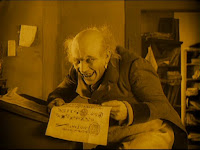To contact us Click
HERE

Director: F W Murnau
Release date: 1922 (film)
: 2007 (DVD edition)
Contains spoilers Nosferatu is, of course, the earliest surviving vampire film. As it is in the public domain it can be downloaded gratis from the internet and bought in multi-dvd sets, singularly and in such editions as the Industrial Gothic Mix, which was the first version I reviewed on the blog, and the ill-advised and ultimately avoidable 3D version, retitled Orlock the Vampire.
As such you need a pretty darn good reason to go out and re-buy the film, especially if it is a fairly pricey set. Welcome to the Masters of Cinema edition. This is the UK release of the Kino restoration of the film and let us talk base film for a moment.
 |
| vampire's carriage |
The film runs at 93 minutes, being the most complete version, I understand, of the film. It is as beautifully restored as it can be and the film is tinted throughout in a way that enhances the viewing experience. It uses the original German intertitles (where possible, or recreates them in the same font) and has optional English subtitles. The character names used are those originally used on its 1922 release and the score is the original Hans Redmann composed orchestral score, which was created for the original release of the film.
 |
| broken coffin lid |
All in all this is the most complete Nosferatu experience as one could have and, for those who might doubt it, this is truly a magical experience – well deserving the 10 out of 10 that I have always scored the film. However there is more to this than just the film. There is a commentary track by R Dizon Smith and Brad Stevens and, on the second disc, a short feature on the restoration.
 |
| shadow of the vampire |
Much more interesting was the 53 minute documentary, the Language of Shadows, that provided a biography of Murnau’s early life, looked briefly at some of his early, and lost, films and then explored the creation of Nosferatu. One of the more interesting aspects was the involvement of the film’s producer and art designer Albin Grau in the occult – he actually stated that Nosferatu, produced by his Prana company, was an occult film. We also hear a snippet suggesting that he had been told of a real vampire incident, during his time serving in the first world war.
 |
| Knock receives correspondence |
This was intriguing but the eighty page booklet that comes with the set goes further. As well as including essays by Thomas Elsaesser, Craig Keller, Enno Patalas and Gilberto Perez, the booklet contains a translation of Grau’s article Vampire, originally published in 1921 in Bühne und Film. In it he recounts being told of the vampire incident whilst stationed in Serbia by a Serb comrade of Romanian origin. The vampire was the Serb's father and the article contains details of an official report, from Progatza and dated 1884, about the incident. Authentic or just showmanship on Grau’s part, as he marketed the film they were about to make? The jury is out, but the anecdote is fascinating either way.
All this makes this a definitive version of Nosferatu. The score is for the DVD set itself,
10 out of 10.
The imdb page is here.

 Director: F W Murnau
Director: F W Murnau 



Hiç yorum yok:
Yorum Gönder